
Bo Atkinson, Maine USA 2021
Even a vague hint inspired me, that all matter might resonate like an electronically loaded circuit, or something like cosmic electrification, where the particles of matter are all powered by a common source, of perpetual power. This idea has long encouraged my search for knowledge, despite that such hypotheses are absent from popular science. A fundamental particle concept is here modeled as a "plug in connector" which is powered everywhere, as the perpetual energy source of organized matter.
At its first posting in 2020, this webpage had attempted to fit a theory closer to the standard model of physics, and this earlier attempt was unsuccessful. A year later with its content reorganized and expanded, the original geometric models remain intact, as independent rationalizations, of a fundamental 3D particle-structure which resonates, and which is sustained by external standing waves of motion.
The trihedral (greenish-blue) form above, represents a nine step, multi-axial helix, (with four converging tetrahedral poles not shown), and the white bulging quadrants represent a sphere, (as a default, generic, smooth object product, and these are products from a professional 3D CAD app).The bulges almost fork through each of the upper tetrahedral faces or divisions, which match the circuited dynamics of special flow structure. Multiple terms, concepts and visual forms are synonymously used, to sort out its distinctive aspects. Trihedral, tetrahedral, polyhedral, spherical, helical and vorticity, here converge as a commonality, (in order to contextualize the hypothesized wave mechanics). Common 3D model formats are provided below, for the adjustable trihedral structure as a geometrical model, for 3D software.
The displayed trihedral form is analogized as a schematic of a universally fundamental particle, the intrinsic geometric convergence of which is tested as a basis of "concentric wave solidification", resulting from four pole, tetrahedral vorticity, (of a trihedral helix). Applicability of this resultant form, is tested as the three dimensional structuration of matter. A variety of geometric variations are together analogized, while leaving the ever finer determinations of parameter distinctions for separate consideration.
Above: Two wave fronts both converging on the left occlude each other's wave front distinctions. (The animated model model is separately displayed.) Presently it is structural geometry under study, offered for testing of it's qualities.
Below: A lower resolution of parameters are shown to convey the triaxial vortex. In the formZ geometry app, there is provided, a generic, helix tool set which enabled this discovery, with its spin directionality, governed by optional clockwise versus counter clockwise windings, (which are expected to generate positive or negative polarity); and in addition, the facetted helix form is optionally smoothed-out in various, optional axial directions, by a separate curve tool. .

Geometrically speaking, white and black figures share the original input source, and were formulated with optional control factors, (which the software can regenerate in a wide range of optional variations, via manual inputs). The white is a smoothed out curve, converted (by a separate tool) from the black-segmented object which consists of just nine straight segments. The white curve is a smoothly converted copy of the black. The lower segmentation in the black wire represents control points for developing smooth curvature (such as the white object). Control points are the standardized, manual-shaping handles for shaping curves, (provided inside geometry software apps).
It is not as yet known why a professional software tool triplicates a helical axis, about a split center of rotation. It is not known why the unequally sized segmentations are generated, or whether the current product contains practical advantages, as-is. Regardless of whether this helix amounts to a programing anomaly or not, in real physical life, the resulting form is verifiable, and the curiously uneven, segment-lengths are yet another matter for study, while this webpage considers both the uniform and our default-nonuniform, segment-lengths, as a valid transition from 2D to 3D mechanics.
The black straight (or facetted) wire helix was formed with two radii of two widely differing sizes, (which is key to this geometric function). The collaboration of these two cooperative radii generates the consequential polyhedral-spherical-helical product, analogized as a remotely powered electrical circuit induced with directional flows; however this presuppose the electrical engineering; and, is here tested merely as a function of higher energies, to be defined as finer materials in motion, finer than those defined in the periodic table of elements; and for this expedient hypothesis, one may suppose that energies are simply finer forms of matter which force or impart motion to larger forms of matter, (as yet to become more clearly observed by science).
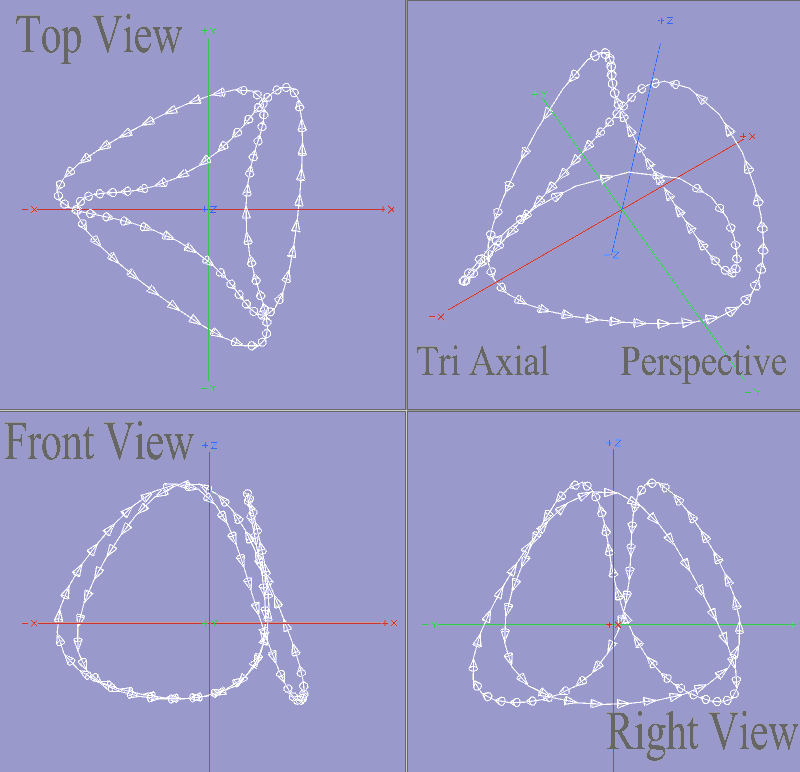
Said otherwise, an orbiting center, instead of a stationary center, unifies a multi-axis-rotary-circuit. Thankfully an older software tool achieves all these steps very efficiently, providing that the software user inputs the stated criteria, in the right order. That which orbits or rotates is taken as the necessary internally flowing configuration, of solid physical matter, and is here symbolized by arrowheads placed along the drawn lines, (and curves), to indicate a perpetuated flow, and by analogy is also hypothesized as the perpetual motion of the universe.
In contrast to well formed particles, an inadequate ratio of radius size may hypothetically account for short lived particle states, and unstable states of matter. An orbital motion around three consecutive orbital axes, as a closed path, may constitute the initialization, of a trihedral waveform as next proposed.
The diagram below shows a facetted helix and its path of winding, both of whose radii are made equal in this diagram, and this ratio of one-to-one, generates a helix around the red equilateral triangle. The fact of two codependent radii instead of one radius is the proposed mechanism to vary particle tightness, both of particle form and also of particle stability. The four diagramed parts, (below), indicate top view on left, perspective view on top right, front view on bottom left and right-side view on bottom right.
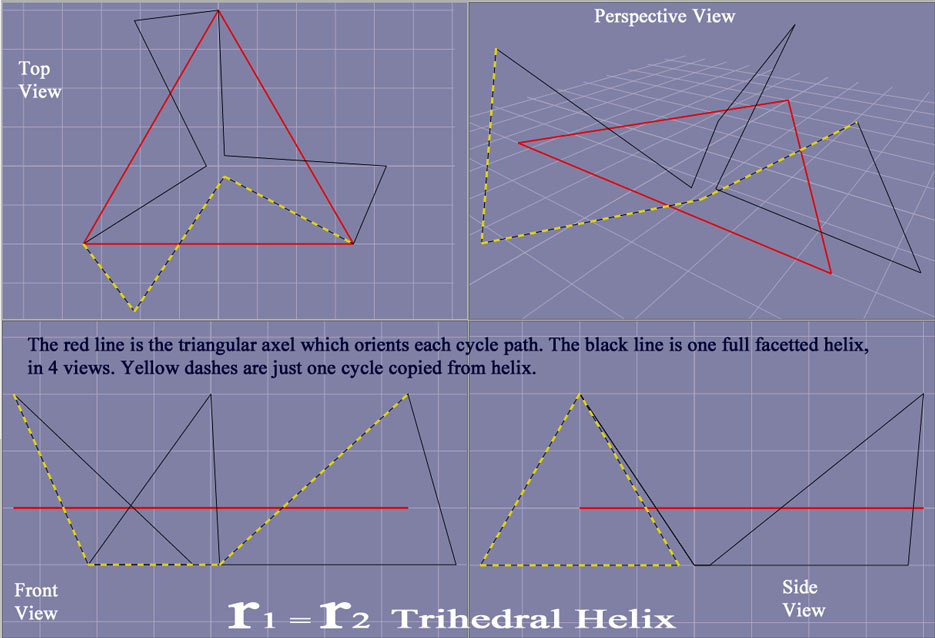
This vectorial diagram above represents the dual orbits, (and optionally as the control points for smooth orbiting curves in earlier images). The primary orbit is an equilateral triangular path in red, while the secondary orbit is the black helix cycling three turns, with nine steps, while the yellow 3D section of the helix indicates just one 3D cycle. Formal geometry defines open and closed wires, segments, surfaces and solids, with potentially useful word applications for particle physics, which are not elaborated in these models.
Below are three displays, one of a close up model to the left, and two zoomed out views to the right of image, as the trihedral helix radius is increased, by sliding (or dragging) the green arrow upwards. The helical radius was enlarged while the vertex gradually converged at the top. The tan color of the trihedral helix signifies the modeling app has the helix under control for increasing helix size, with the green arrow, to slide up or down, centering on on the red-line, (imagined as axel-bearings for radii and indicated by green dots, to left side of image). To the center and right of image: The tan lines or edges of the trihedral-tetra helix have increased much larger, and the red is too tiny to see. By starting close-up (on left of image), the display has to be zoomed way out to progressively see a trihedral tetrahedron (to right of image).
The image below emphasizes the converging vertices to refine polyhedral facets, integrally with helicity.
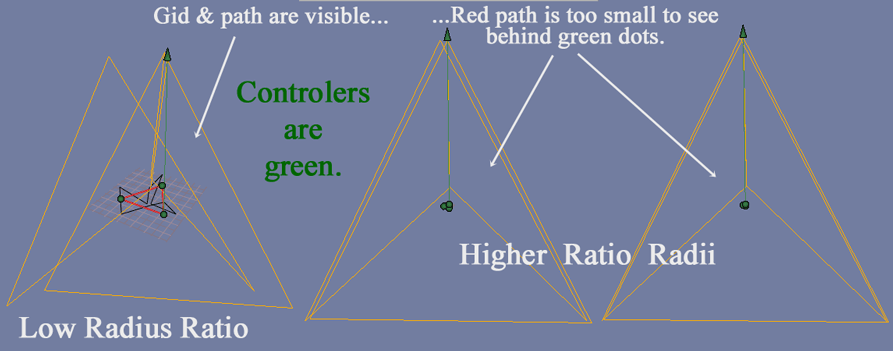
Resilient tightness of edges, might be a necessary rule for the physical property of particle stability. Too small a radius loosens the polyhedral seams. (This refers to the secondary radius mentioned above). The natural rarity of observable short lived particles, may be due in part, to this instability. The smallest ratios of secondary radii, which geometrically form cruder or broken looking enclosures, might well account for the unstable accelerator products as smashed particles, (the so called atomic zoo). Could tight enclosures well describe stable particles?
Specific meanings of trihedra and tetrahedra are both, partly applicable in this hypothesis, because both meanings find applicability in some finer points of this model, and both definitions also overlap proportionally. Trihedra are the simplest enclosures, as defined by fewest parts mathematically, also having a triangulated stability, and furthermore as a helix may form the inherent spin, (which may furthermore offer polarity and force orientation, like electrical charge, through the uncovered base. Next, consider the nature of this as a convergence, with seemingly sealed up trihedral edges, (due to very high ratio of radii, as noted with r1 and r2, along with a much more noticeable "open vertex".
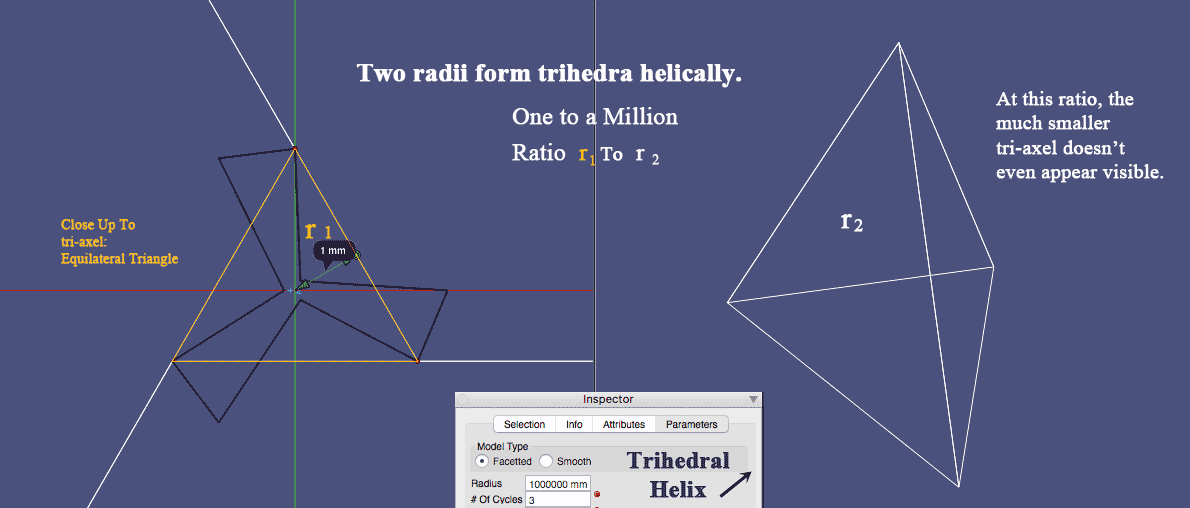
Another note on visual appearance is the 60º projection of a 3 point perspective, above to right, as compared with the close-up, 0º axonometric view to right above, (achieved by zooming in and out of the 3D model). Three sufficiently closed helical loops and one resulting open helical loop, bind together as a self stabilizing, trihedral helix.
The multi-view image below is all axonometric, (equivalent to zero perspective and this explains the flatter look of the angled view).
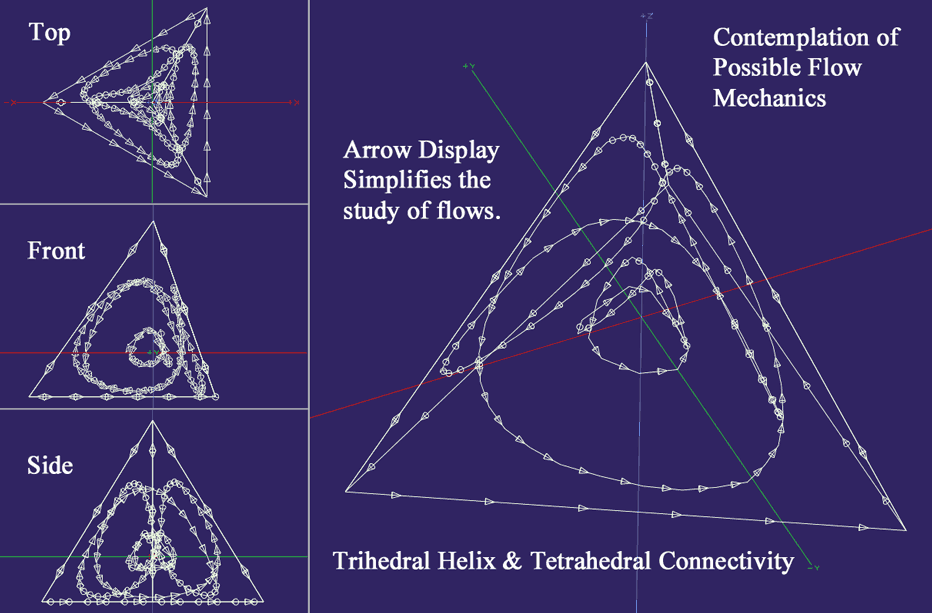
Would two, codependent, orbiting paths clarify particle functionality, as compared with singular pivotal-spins? Rotation and flow are key particulars and other properties were also studied on an earlier webpage, (link).These trihedral models may be tested to explain the most fundamental particles as, a pyramidal framework which branches a polarity in three directions from the base, (one branch through each pyramid face and one root as the base). A 3D geometric stability might satisfactorily describe a 3D universe stability, to be further considered, for higher ratios of r1 and r2, which tighten up the edges.
These geometric frameworks present multiple conceivable connection modalities, which must be rationalized with other scientific facts, before devoting too much time to speculative 3D modeling. If physical evidence demands a tetrahedral form factor, then the trihedron can be manually adjusted to match, and this can be manually modeled without loosing finer features. The parallel edges which are finely separated, provide one infinitesimal crack on each of the three vertical faces, symmetrically angled at 120º from each other, and the exacting ratios of proportions is worth a closer mathematical evaluation, which may assist designing experiments.
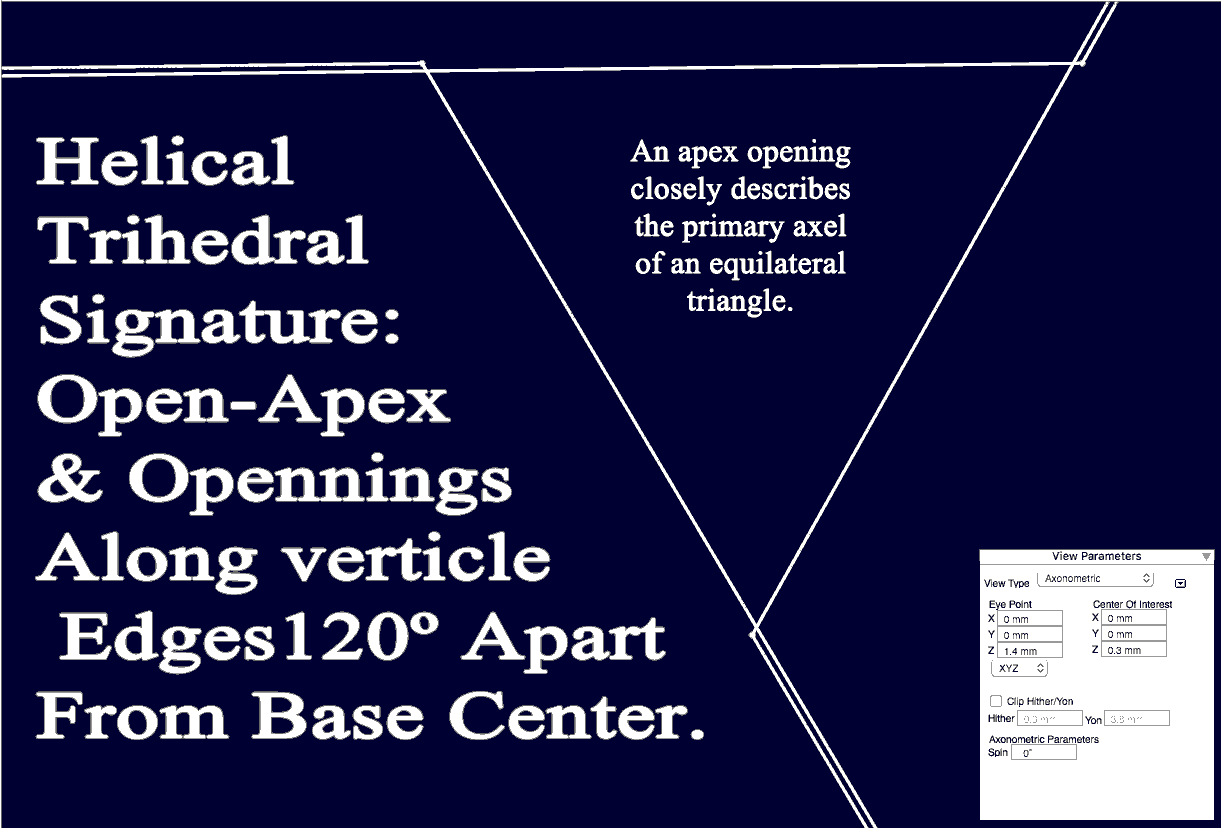
A "tiny hole" at the trihedron apex can illude observation, but zooming in closely does reveal it clearly, (as in the image above). It projects as the same size to the tiny triangulating-concentric-axel. The image above magnifies the hole with it's signature separation of parallel wires, which become closer at higher ratios of r1 and r2.
Note that the formZ version 9 app forces a 'covering' (as they call it), on to helices, which can be removed with their 'Uncover' tool, and this default covering does obscure the open apex observation when shading of the display is enabled. Unfortunately for the experimenter, this removal of the unwanted covering voids the parametric adjustability of the helix, except and unless an older version of formZ is used, in which case the parameterization of the helix is preserved for experimental editing purposes. Versions 8 and prior versions dating back into the 1900s all benefited from the same helix tool without this obfuscating 'covering'.
The basis of this 3D model was discovered long before attempting to detail it's potentials for atomic applicability. The possibilities seemed conceivable, but detailing and organizing the loose ends seemed overwhelming, without knowing of any supportive basis, until an already posted theory was found on the www, and the effort to fit that theory is described in detail further below).
Would branching polarity trough tetrahedral faces differ from conventionally taught linear polarity? Could multi axial, codependent, orbiting paths clarify particle functionality, as compared with singular pivotal-spins? These trihedral models may be tested to explain the most fundamental particles as, a walled in "surface object", which shapes a branching polarity, which might subsequently govern atomic bonding rules.
One definition of good or clean geometry is absence of crossing faces or crossing segments. A non-self-crossing, smooth outcome can otherwise be manually obtained by converting the faceted trihedral helix into a plain object, (free of parameterization), and then converting it to a desirable curve, (as there are multiple kinds of curves to suit a purpose like visualizing the results displayed on this page).

The formZ, built in option of helix parameters offers this instant, optional spherical representation, (blue curve). It appears as a physical wire strung around one common center and four vertices in a polar fashion, which looses the trihedral surface-solid or boundary representation. So that the truer trihedral helix is lost in the rounding off of typical helix-tools, and therefore the curved or smooth representations must instead be manually derived. At some point I must learn how to explore these parameters in Rhinocerus 3D software.
Other parameterized tools, (generally known as smooth geometry for curve and surface editing), were partly explored for helical modeling. The following is a semi-transparent model based on the same 3 cycle, 9 step, faceted-helix. The value of this type of smooth object would be to further explore possibilities of internal-particle-sphericity, omnidirectional, trihedral spin and conceivable properties in 3D space. (The model below is a simple conversion from a facetted version of the helical tetrahedron into a default smooth object. Smooth tools provide for multiple solutions of varied forms, which at this point are less pressing to review. The default crossing faces deserve exploratory editing.
______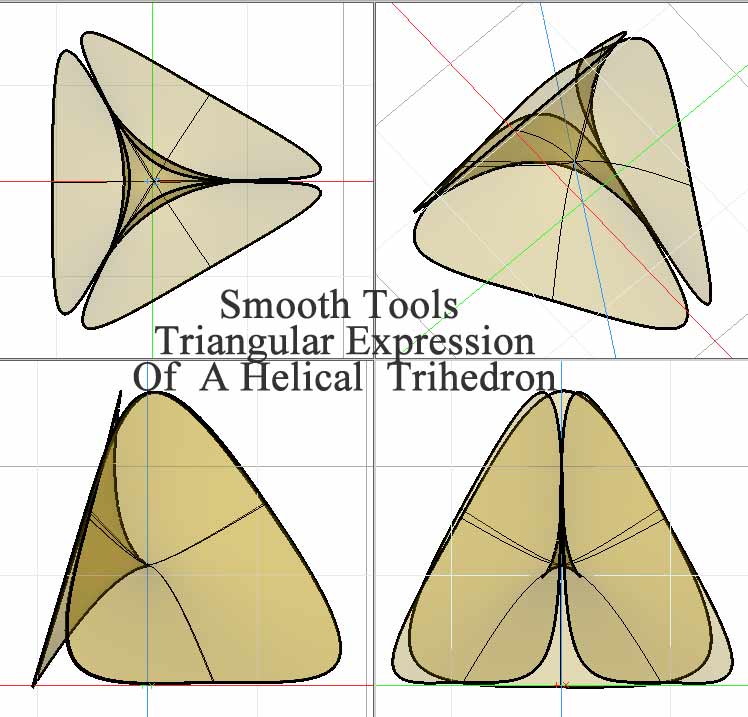
In the spirit of collaboration, I invite interested persons to discuss this subject matter, and the modeling approaches, possibly through The Field Structure Institute zoom account, or other venues, emailing, etc. is also welcome. Please test the 3D model with your 3D software at your convenience, and let me know if the files need refreshing as this website has lost some data, over it's many years on-line.
In the spirit of free software uses, here is a quick way to immediately see the arrows intrinsically within a 3D software app. Other, excellent software brands have lacked this particular automated arrow tool, and instead offer other sorts of excellent, automated tools. Verifying this model with other modeling software brands may add some insights. Otherwise for immediate, cost-free viewing of this model, with its arrows intact, the formz free app, 0$ for Windows & Mac is downloaded here.
Automatized arrow checking simplifies a more detailed modeling of directions, polarities and chirality, but the model above is at a simple, preliminary stage. (This display option can be easily toggled, or turned on or off, under formZ/Menu/Display/Display Options, and at the bottom of the dialog-panel, the "show direction" box can be checked or unchecked, to toggle the display of arrows.) Far greater detail of flows is easier to model in this way, with repeated toggling, to better distinguish geometrical parts and hypothetical parts, and to avoid a lot of manual modeling work of modeling the arrows manually. Direction of vorticity is possibly key to considering atomic mechanisms, where the modeler can reversibly model the direction of segments and quantities of arrows, very easily.
It is known among 3D modelers that importing and exporting certain 3D formats looses specialized modeling features such as arrows and other things. Only plain conventions like lines, surfaces and solids, have been reliably universalized. Conventions of handling geometry also varies from one app brand to another. and yet access to highly developed software is made free, to preview the full potentials.
Plain 100:1 Ratio Trihedral Helix:
faceted-trihedron.sptFacetted trihedral helix with internally facet-rounded, trihedral helices, (but only formZ will automatically display the arrows as an option already built into formZ). This option can be turned on or off under formZ/Options/Display Options.
The formZ apps natively display flow like arrows:
In recent years formZ added a default auto-surfacing feature to its helix tool, and if the surface component is removed from the helix, then the helix -parameters are sadly lost. Adjustable parameters allow the observer to study the effects of vast ratio-zooming, to contemplate the effects of a nano radius upon the macro world. This may call for keeping copies of the parameterized helix along with the naked wire helix, which is more work than the older formZ version. Yet the surfacing feature is otherwise useful to envision the helix as a surface solid, except for the obscuration effect at the apex.
Next described are the attempts to model the splitting of multiaxial polarity in the helical trihedron. All the preceding trihedral and tetrahedral modeling has represented the possible inner workings of spherical standing waves, which are finally merged into the sphere of influence.
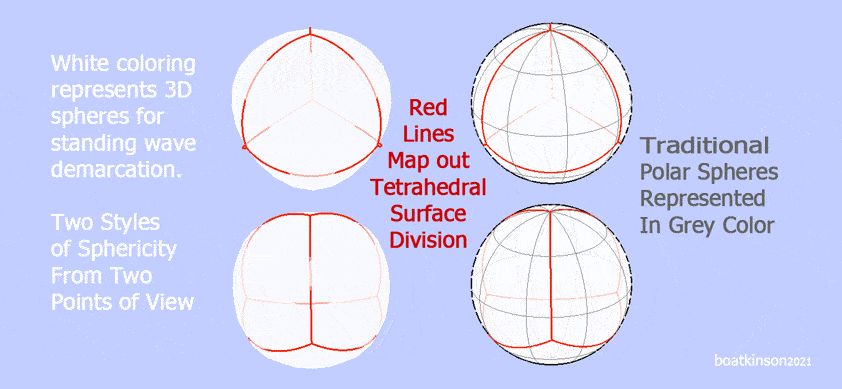
Resonant, spherical waves are taken as the fundamental particles, and the demarcation of organized matter. Interspace between spheres is taken as a maintainer or conduit of the common resonation. Comparative or interchangeable versions of smooth and facetted geometry avoid a premature specialization of form or sphericity. A "branching polarity" may deserve a more particularized styling of spheres rather than the traditional polar mapping of spheres, because the innards are hypothesized as multi axial and rotatory, and this indeed is in contradistinction to a spinning ball analogy, orbiting around a sun.
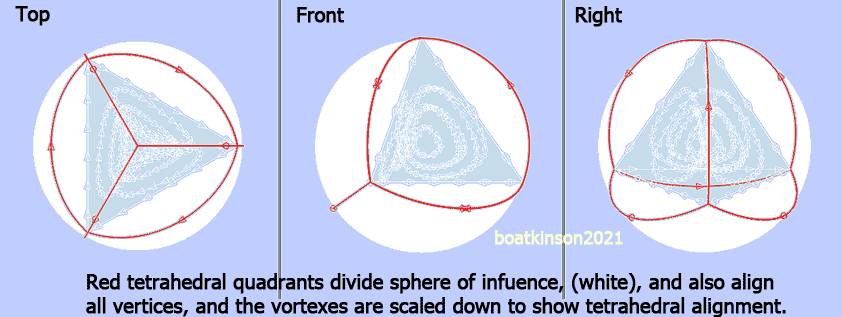
Tetrahedral quadrants divide and define a sphere of influence, and also align with tetrahedral vertices. The three vortex axes branch one pole each, while the converged base axis is of opposite polarity. Rotary directionality is a key property of physical, organized matter, and the trihedral spacing between parallel, neighboring edges does insulate the opposing flow directions, while the base of the trihedron bears just one direction of flow which internally branches through the upper three (as a multiaxial split polarity).

Geodesic sphericity is next used to contemplate the nature of Interspaces, starting with arguable arrangements of tightly packed spheres, followed by other arrangements of necessarily, more spacious Interspaces Geodesic spheres will here imprint the the interspace surfaces with its ambiguous polarities or many subdivisions. Only further below will bonding of spheres be briefly touched upon, as this webpage intends only to analyze the preliminary idea of standing wave particles.
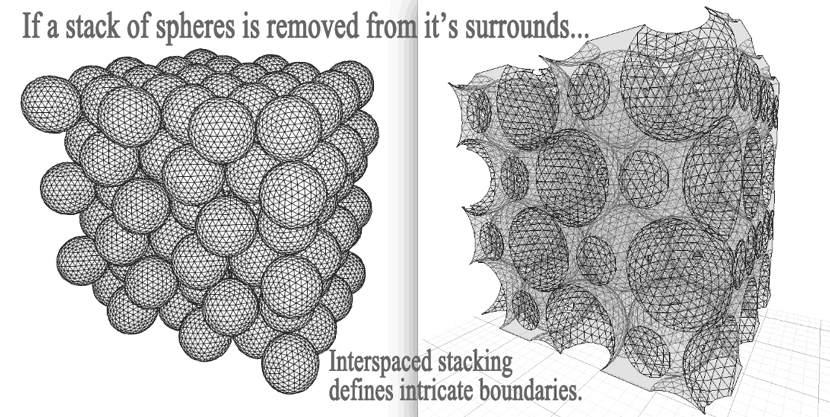
The model of geodesic sphere packing, (above), reveals that interspace is not uniform as it is with four touching spheres. The emphasis here is that even a tightly packed interspace provides a spacious potential for an omnidirectional confluence of conduction, supportive of powering countless standing waves. Absolute, concentrically omnidirectional wave pressurization, absolutely flexible to concentrate a concentric wave front around each spherical wave, is expected to sustain the universal resonation, (the extremities of which would encompass the whole universe).
This hypothesis is partly borrowed from hylozoic working hypotheses which helpfully explain organization of existence. Here then are imaginative explorations to develop human meanings.
Next, just four spheres are modeled to carefully observe the form of the resulting interspace, which for lack of a traditional name, is here called a "quad-joint". In this webpage hypothesis, the word 'void' and 'interspace' are considered absolutely dense transducers of resonant "raw motion", concentrically pressurizing particles of organized matter, which accounts for the solidity of matter, which is thus observable by life, but by beings without perceptive organs attuned to said "raw motion". This tightest possible arrangement of four spheres is not mathematically found repeated as parts of the stacks and rows, of the first image immediately above.
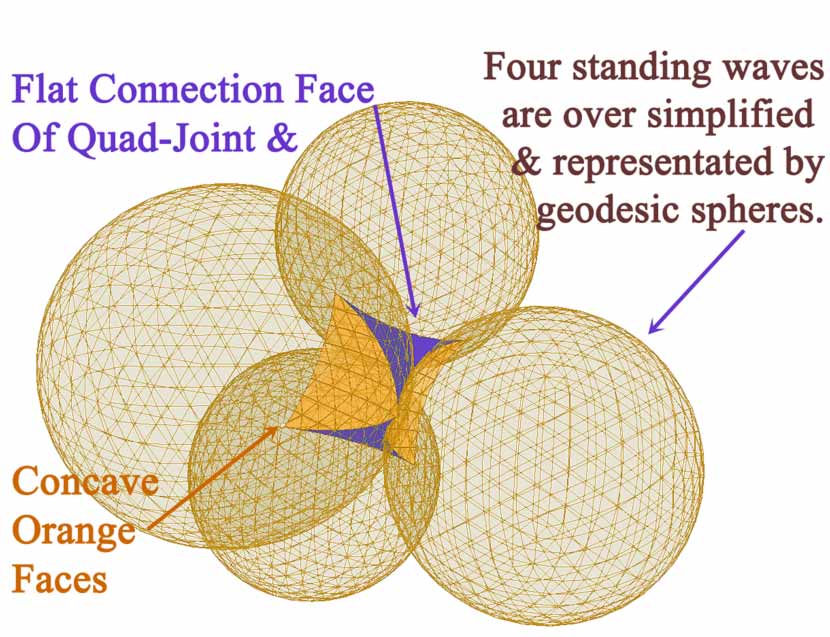
Quad-joints have four concave sections that we might call spheric parts or faces. These concave sections could be imagined as constituting one general face each, and the remaining, four, purple faces, are cut flatly to differentiate from neighboring quad-joints.

A minimum possible space between four identical spheres which mutually touch, has four segmentations, (purple faces in drawings), leading to connected, subsequent, segmentations, but perhaps more importantly cannot account for the all Interspaces, because economically spaced stacks and rows do not meet in that specific tetrahedral alignment, and therefore other proportions spaces between the spheres result, and could not fill all interspace with quad-joints.

The next model below represents rows and stacked spheres, all sliced to show another version of Interspaces The (green) object on the left is used to boolean-difference the (tan) model on the right, the differenced result of which reveals an unbroken, non-linear, networked space. This version of networked interspace is just one example of many possible varied networks of interspace.
These examples simply indicate an unbroken interspace function with the tightest imagined sphere packing. Purely geometrical studies of sphere packing are separately published by many other people on the www, which might suggest a variety of conceivable, spherical arrangements, which are beyond the scope of the present hypothetical geometrical layout of spherical standing waves and Interspaces
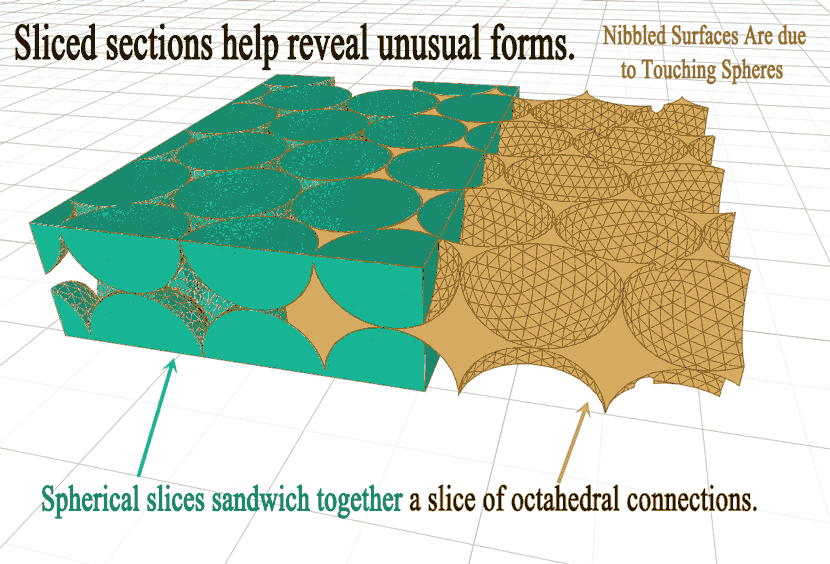
After describing the jump start of this webpage, inspired in part by EWT, an additional attempt to describe other sources of its inspiration is will be made.
After listening to an interview with guest Jeff Yee and host David de Hilster, of August 30, 2020, through The John Chappell Natural Philosophy Society (CNPS) at The Natural Philosopher website, a strong urge to jump start my competition entry began, to submit a fundamental particle model, which could fit the The Energy Wave Theory (EWT). The significant prize motivated many long days of 3D modeling and writing, but this effort could not be completed before the short term deadline, and it was instead submitted a month or more late. I decided to post my work as this webpage, which was subsequently edited a few times, until it was completely rewritten in December 2021, with new models added, while this page still retains the EWT inspired, free exchange of ideas. As of this writing, the original 2020 EWT modeling competition webpage, which had announced the series of competitions is not found on the internet. I am very thankful for last-year's competitive kick start, to begin testing these working hypotheses, by posing a lifetime of collected, and reconfigured cross references, into one work.
A low resolution and very simplified, geometrical simulation had been originally submitted for the EWT competition, and is linked here: Animation.
The following trihedral innards of spherical waves were included in the original presentation, and lacked sufficient representation of the surrounding sphericity. Could single or multiply, bonded, trihedral frameworks, as internal standing wave mechanisms, constitute an atomic or sub atomic particle ? Could multiple frameworks bond geometrically at the vertices? Might ten trihedrons connected at vertices diagrammatically indicate that all arrows synchronize like gears to achieve bonding or to increase force field effects?
2020 EWT Quote: "In energy wave theory, the electron is formed from a collection of ten wave centers (neutrinos), expressed in the wave constant variable K=10..." Diagram below assumes trihedral,fundamental particles may stack together. Connections at vertices are considered.
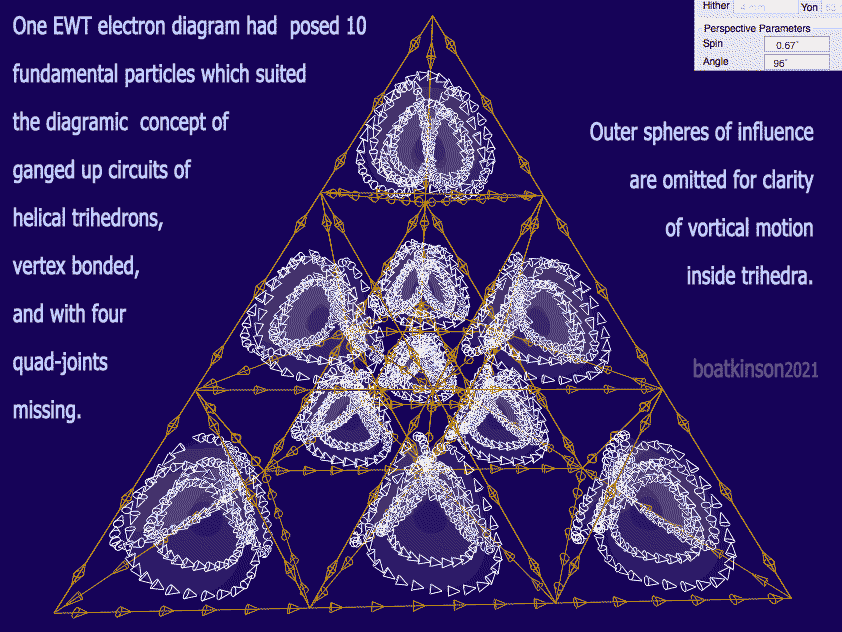
This diagram omits the smooth spheres to clarify the mutual alignment of bases and apices which may well 'cup' a greater amount of wave pressure from the base end, and in so doing gain more linearly directed motion, and correspondingly with weaker vorticity from the branched polarities; because, the pyramidal branched-poles diffuse their directionality while their base conserves its one direction of interaction, with the external, standing wave resonation. Possible varieties of pyramidal arrays are expected to build towards measurable energies, when measured with denser arrays of relatively stationary matter.
It should be emphasized that the open source EWT project focusses on other work and not this work on this webpage. Nevertheless, EWT provided the impetus to organize this author's collected concepts, which explore the mechanisms geometrically, including the bordering inter-spaces, existing between and around all matter, wherein particulate matter is hypothetically visualized as complex, polyhedral aggregations of more fundamental spherical particles, and most importantly that all such local interspace invariably connects very distantly due to absolute pressures involved, hypothetically, as continuous conduits of perpetual empowerment. The proposed functions of this networked, inter-spaced conduit would be to conduct flows of empowerment everywhere from one concentric source.
This webpage is politely disregarding volumes of evidence obtained from particle accelerator collisions, which are given official credence, to determine elementary particle classification. Until all the smashed atomic particles can be put back together in the original forms, the explanation of atomic matter has not been demonstrated. A constructive standpoint is instead searched for here, to model a perpetual flow mechanics which sustains worlds and life. Up to this point only some geometrical evidence and less known collections of ideas are simplifying a possible 3D structural approach, to describe atomic matter.
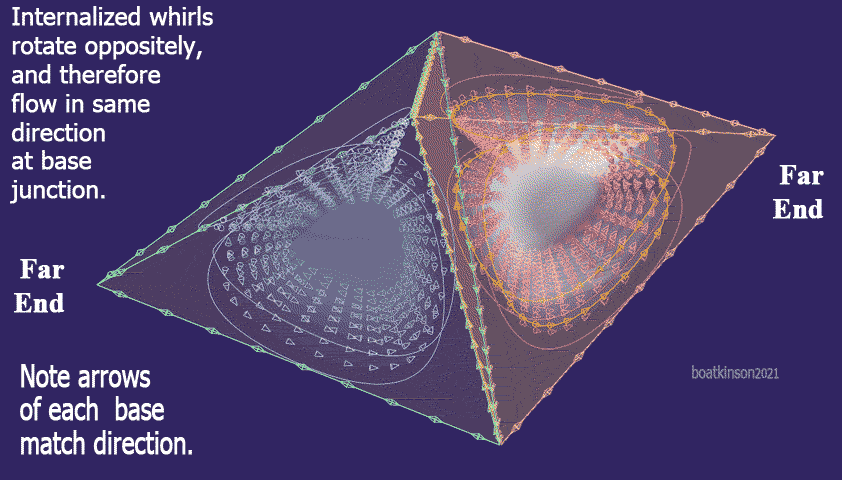
Could positive and negative polarities of particles imply specific directions of rotation? Next, the red and blue coloring indicates that the same trihedral frameworks simply have the arrow directions reversed, and therefor the base arrows are pointing in the same direction. Arrow directions can otherwise imaginatively be drawn together with reversed arrow directions at the trihedral base, to analyze all possible mechanics of base bonding. A more specialized, physically tested principle is an additional application of bidirectional arrows which might be tseted in these models, where see: RadialPoleCoilParamagneticOrDiamagnetic.html
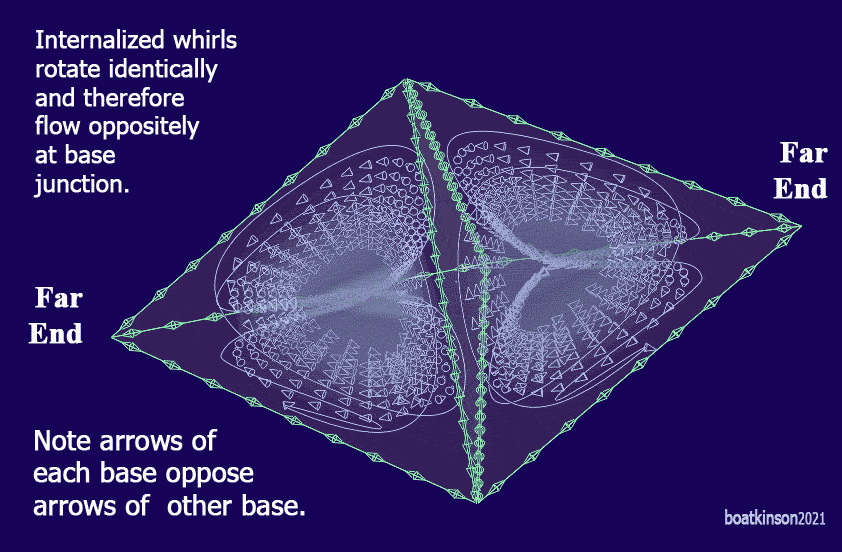
Could reversed arrows shaped like two typed character, <> , signify stability, similar to geometry's rules of well formed objects? Geometry offers multiple modes of assembly to consider and compare the theoretical-micro and the physically-built-macro systems. The intent behind images above and below only indicates that variable alignment and chirality factors can be graphically modeled together for analysis of hypothetical-natural laws.
Could perpetually whirling and standing waves comprise the fundamental particle of organized matter? Could this helical trihedron be maintained (or powered), by forceful and symmetrical vibrations, in concert with neighboring particles in the universe? Could these forceful vibrations operate in the interspace domains described earlier?

Next, examples of bonding at vertices are modeled with symmetrical alignments. The finer details of arrow and circuit analogies are not further explored here, and are rather left as open examples of possibilities that fit mechanical analogies

EWT had focussed on classical equations and constants to determine geometric relationships, whereas this webpage only explores particular polyhedral structures. This star tetrahedron model may or may not omit the central tetrahedral vortices, (graphically speaking), which poses further open questions about the differential properties, of "thorough solidity" as in classical tetrahedrons versus "surface solidity" (of trihedrons), and both concepts question what observations may result in physically electrified hedrons of these models.
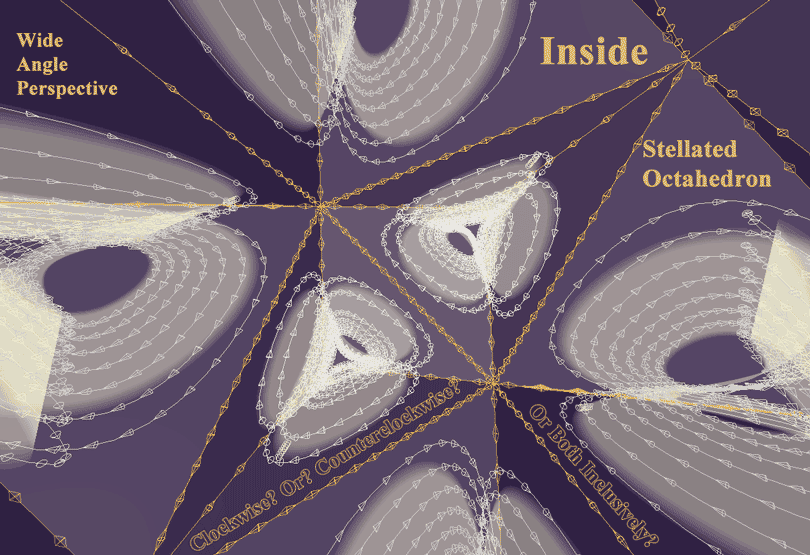
Geometrical computer modeling became affordable, around the mid 1990s, when I found the formZ app which included platonic solids modeling, smooth formed NURBS modeling, curves, spirals, colorful rendering, text and printing, along with good educational support, all in one package without any need of specialized programming skills. This combination suited many expedient needs. Many other kinds of inspirations of life, along with idealized forms of geometry are milestones of evolution, planted in higher dimensions to pour downward as energies into our lower three dimensional world, which can naturally motivate lower beings, to grow forwardly in knowledge, and thrust our way through and beyond the densest, condensed matter.
The 3D software apps are becoming easier to use and to model concepts of 3D material structure. Here is a link to my earlier work with fractal tetrahedral and octahedral bonding, as 3D visualizations.
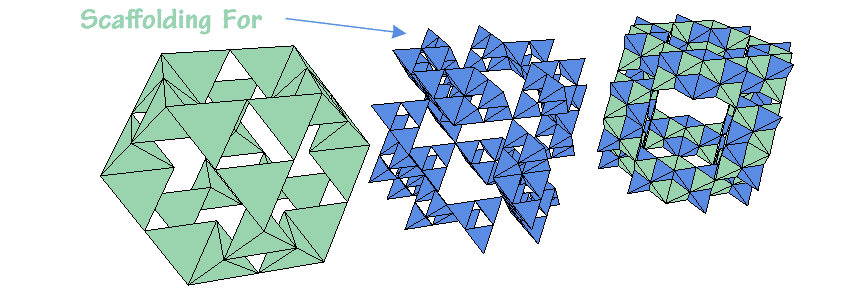
Discussion is welcome:
![]() .
.
A lifetime of collecting many sources of knowledge provided multiple concepts to build out the framework of this webpage were too generalized to to fit, while EWT had seemed aa appealing approch, for its classical physics considerations, to contrast with other sources of ideas, which can then build towards a deeper and more productive explanation of physicality within all existence.
Little known, generally unexpected, and likely rejected at first glance, is the Pythagorean hylozoics, with explanations that motion is a distinctly fundamental aspect of existence, apart from matter; and, that energy is actually much finer forms of moving matter, all of which man has yet to discover. This part is a hylozoic explanation.
Pythagorean Hylozoics explains that matter and motion have naturally gotten confused, in traditional physics, and that hylozoics has only recently had a preliminary disclosure of it's own presentations, offered in PDF books, available online, which explain existence as a whole, and far beyond my meager models discussed in this webpage!
Furthermore, hylozoics has made no mention of tetrahedral structures as presented here on this webpage, which are my freely exchanged ideas, which have increasingly adopted the ideas partly from hylozoics, as hypotheses must be worked out by each seeker of truth, and without indoctrination. Plato's academically given history is also corrected in hylozoics. Socrates claim that he knew nothing worth knowing, is given as a basic scientific precaution.
Hylozoics is much more and far beyond a human construct, as it explains extensively, which at this stage of human development must remain highly restricted in its scope, due to man's own, "unspeakable suffering, his hell on earth, that men cause each other and all other living beings". Yet the appearance of this recently, www posted hylozoic presentation, marks a milestone of human readiness for its teachings. Much is given to reinforce the common sense of science, but it stops short of any empowerment to enable more harm to all life, of which mankind must cease, and instead to peacefully develop sciences, to evolve all life harmoniously, as a priority.
Historically speaking, esoteric hylozoics explains that the real Pythagoras, apart from the academic and speculative historical writings, was forced to hide his legacy and teaching, due to the all- demolishing power politics, which has governed men while only gradually evolving beyond barbarism, and which still plagues man until today. Evidence of disguised slavery still blemish society, until mankind and its governments manage to develop consciousness, (much higher). Higher knowledge of matter and energies is given to mankind, (as gifted scientists were incarnated world wide, which is an independent source and is not traceable through genetic inheritance). Mankind was provided a wonderful planet, within which to develop consciousness, and man has self willed choices, to the extent that his societies are free, and to eventually discover higher laws, and to incorporate these into national laws, and into common laws, and global laws. We are on our own and we must develop our own path through cosmic evolution, without the lower forms of emotionality, and without deceitful scams.
Esoteric hylozoics, (Pythagoras’ doctrine), branches beyond popular sciences, to explain all life, to stimulate self development of consciousness, through steps like increasing awarenesses of all life, rather than to remain caught up in subjectivity, where there is no consciousness development. Solid material observations are key to avoiding subjectivism which can enslave the mind, as history shows that subjectivism failed to develop consciousness. Therefore an emphasis on verifiable modeling has been made in this webpage.